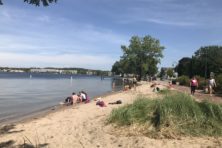Sister Bay Receives Beach Buddy Designation
- Share
- Tweet
- Pin
- Share
The National Resources Defense Council has recognized the Sister Bay Beach as a Beach Buddy, an honor bestowed on communities that take aggressive action to monitor and clean their beaches.
A press release from the NRDC said, “Beach Buddies are communities that monitored beach water quality regularly, violated national public health standards less than 10 percent of the time, and took significant steps to reduce pollution.”
Door County’s beaches have been under heavy scrutiny since contaminants led to the closing of Nicolet Beach in Peninsula State Park in the summer of 2002. Subsequently, Door County communities have implemented comprehensive testing of beaches and taken steps to mitigate pollution from storm water runoff, watercraft, shoreline development and other sources.
Sister Bay Village Administrator Bob Kufrin said the Beach Buddy designation is recognition of worthy village efforts. The beach has had just one closing the past two years, which Kufrin said came immediately after dredging was done adjacent to the beach, stirring up sediment along the shore.
Much of that good track record is owed to steps taken to make the best of a bad situation created by an infrastructure failure three years ago
When the sewer collapsed beneath Bayshore Dr. in 2004, the village spent an extra $50,000 to 60,000 to install a storm water treatment system under the waterfront park to filter runoff before it gets discharged into the bay. Kufrin said village employees have done a great job keeping the shorefront properties clean by raking and cleaning daily.
“We’ve been very aggressive in monitoring activities around the beach,” he said. That includes taking steps to minimize impacts from bird and dog droppings, which contribute to spikes in E. coli levels when they’re washed into the water.
Kufrin also explained that the village has embarked on a storm water master plan that would hold the village to a much higher standard than is mandated by the state for a community of Sister Bay’s size.
“We’ve invested tens of thousands of dollars to develop a plan as part of the CUPAC (Comprehensive Utilities Plan Advisory Committee) study,” he said. “We’re reaching for a standard that only cities with a minimum population of 10,000 have to reach.”
Sister Bay has a population of just 886, but Kufrin said the village board is well aware of the importance of the shorefront to the community’s economy and pride.
“They recognize the beach, water quality, and the shoreline district in general represents the best of what Sister Bay has to offer to visitors and residents,” he said. “If we didn’t do something proactive, the community could take an enormous hit down the road.”
Kufrin cited the recent decision to purchase Helm’s Four Seasons, a property next to the beach, for $5.5 million as a prime example of the board’s commitment to the shoreline.
“That property would likely have become condos, creating more runoff and more problems,” he said.
Sister Bay was nominated for the recognition by Gregory T. Kleinheinz, R.S., Ph.D., Director of the Industrial and Environmental Microbiology Laboratory at the University of Wisconsin-Oshkosh. Kleinheinz was part of the team that worked with the Door County Soil and Water Conservation Department and Door County Health Department to evaluate beach water quality and to develop beach management plans to protect Door County beaches.
The NRDC compiled data on 3,500 U.S. beaches for the report, which this year takes an especially close look at the nation’s highest risk beaches – those that are either very popular, very close to pollution sources, or both. Of those high-risk beaches, Ohio, Indiana, Illinois, Rhode Island and Minnesota ranked the worst for failing to meet national health standards.


